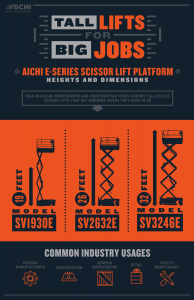According to a study published by Global Market Insights in February 2018, the rental market for aerial work platforms is expected to reach $24 billion by the year 2024 (up from around $15 billion in 2016). This sharp increase in demand is largely attributable to the booming construction industry with scissor lifts seeing the largest increase in equipment demand.
And it makes sense. Scissor lifts are practical, inherently safer than using a ladder, and they’re a more economical solution than many other powered types of equipment. So how do you choose the right scissor lift for your application? They’re all essentially the same, right? They travel and lift and lower and that’s usually good enough to get the job done isn’t it?
Well, not quite. While many people tend to focus on the upfront cost as the only factor when purchasing or renting this type of equipment, this could end up costing you in reduced efficiency, performance, and safety, among other factors. This guide will help you understand these factors and make a better, more informed decision when it comes to the type of equipment you want on the job site.
Scissor Lift Purchasing Factors
Exterior Dimensions – Scissor lifts come in all shapes and sizes with different lift heights, platform dimensions, and lifting capacities. Make sure to choose one that will work in your space constraints that can also meet the demands of your application. Having a lift with fold-down guardrails and an upper control box with remote, off-truck capabilities can also be very helpful for traveling through doorways and working in tight spaces.
For reference, check out Toyota’s various scissor lift sizes. They’ll give you an idea of various options.

Safety – Consider the construction of the scissor lift and the features that it offers that can help reduce the possibility of an accident. Scissor lifts today, such as AICHI’s E-Series models, offer advanced features such as anti-rollback on grades, controlled descent when lowering, and reduced travel speed with the platform elevated to reduce the likelihood of a tip over or injury.
Efficiency – More efficiency equals longer run time and longer run time equals getting more work done between charges. Some scissor lifts utilize hydraulic steering and DC drive motors, which aren’t efficient ways of converting energy and also require more maintenance. AICHI’s E-Series scissor lift models have industry leading cycle time thanks to their highly efficient AC motors designed by Toyota.
Productivity – The travel and lift/lower speed capabilities of your scissor lift can have significant impacts on productivity, but they aren’t the only factors. The key is looking for a machine that provides smooth, precise control that instills confidence in the operator. Additional features such as a zero degree turning radius and a power outlet on the platform can even further increase your overall productivity by spending less time navigating tight turns and getting on and off the scissor lift.
Written by: Lucas Collom, Digital Projects Administrator, Toyota Material Handling, USA